Timberland Safety Boots That Keep Feet Safe on Any Job (Reviews) 2023
Timberland’s Pro line of safety boots is the branching evolution of their classic yellow work boot. Nowadays, this trusted boot maker has got the perfect footwear for almost any job, featuring high-quality materials and peerless workmanship.
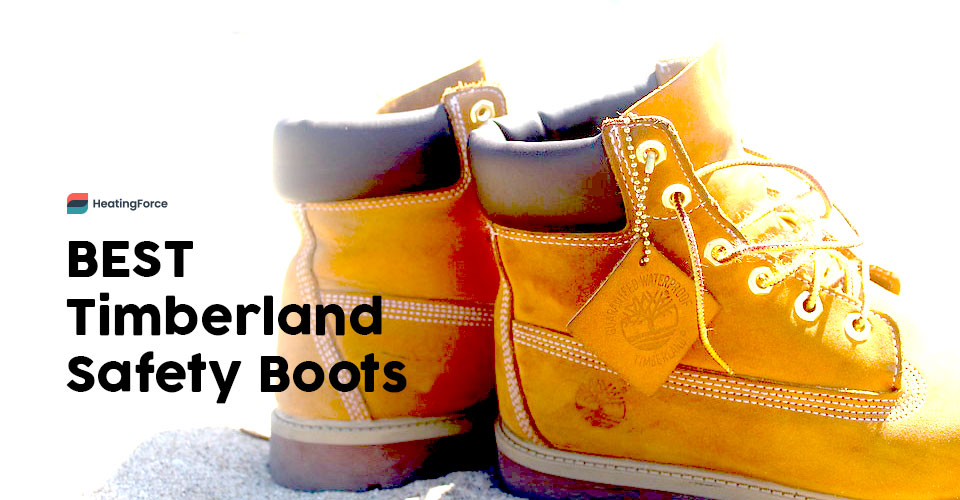
Today, we’re looking at five of Timberland’s best safety boots, each descended from the classic yellow work boot and equipped for the modern workplace — wherever it may be.
Stay tuned to the end of the article; we also go over what makes a great work boot, how to keep yours up to code, and give you a crash course in what those safety standards are.
Best Timberland safety boots
Timberland brings extensive experience to the table, as they go out of their way to learn the specific needs of various industries. The result is a bustling Pro line of safety boots, each with unique construction methods and feature sets to serve their wearers dutifully.
Below, you’ll find our in-depth reviews on five of Timberland’s safest, comfortable, and most durable safety boots:
1. Timberland Pro Direct Attach 6” Steel Toe Boots
Looking for the boot that does it all? Timberland’s Pro series has a ton of options, but the consistent bestseller is the Direct Attach 6” model safety boots with steel toe. They’re comfortable, rugged, protective, and have that classic Timberland style you love.
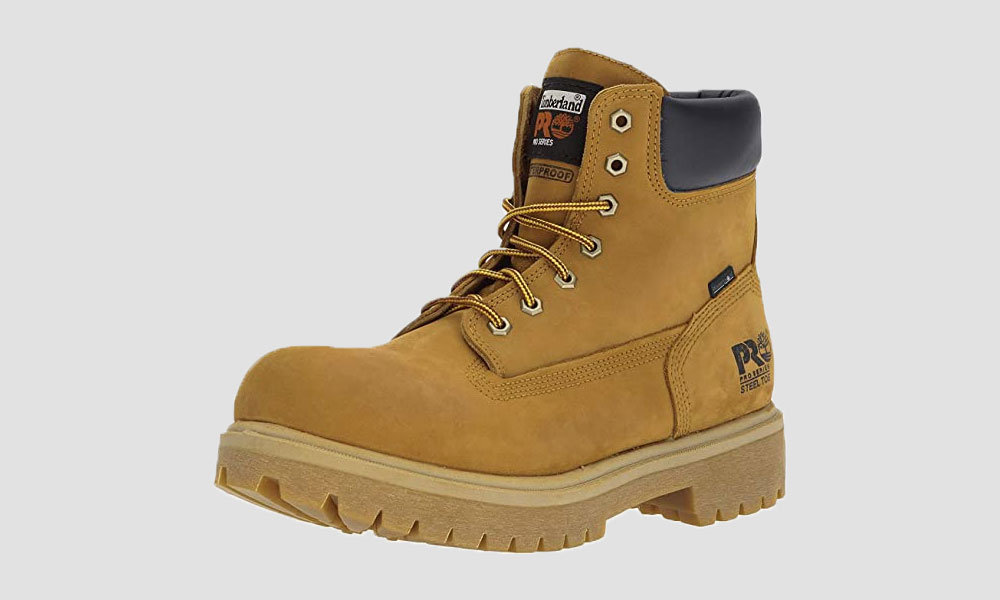
Construction, comfort, and fit
Timberland didn’t cut any corners with this boot, which bears superior workmanship and quality materials. The trademark yellow full-grain uppers provide genuine waterproofing, wear hard, and look great. As the name implies, the Direct Attach safety boots attach a mould to the uppers, then fill in with molten rubber to form an integrated sole. The difference can be immediately felt, as this allows for a lighter, more wearable boot.
At the heart of the Direct Attach 6” boot is a polyurethane insole, built to breath and keep moisture at bay. The next layer down is an anatomically contoured plate, which diffuses shock, provides support, and enhances the rigidity of the boot to prevent rolling. At the base is the non-marking rubber outsole, topped with a flexible blown-thermal plastic midsole.
The counter, shaft, and vamp are all joined together with a quality triple stitch. Along the collar is generous padding for a comfortable fit.
Safety features
This is where the “Pro” comes in. The Direct Attach 6” meets with ASTM F2413-11 I/75 C/75 standards in large part due to its special asymmetrical steel toe cap. Moreover, the bold rubber sole provides exceptional electrical protection vs. open circuits, and meets with ASTM EH standards so long as it’s in good shape.
Timberland knows protection doesn’t just stop there, as both hot and cold weather can threaten your foot health. Thus, they’ve outfitted the Direct Attach 6” safety boots with 200g of thermolite insulation. To further control your boot’s interior environment, there’s also an anti-microbial mesh lining to wick moisture swiftly away.
The specially tanned leather and outsole combine to provide an effective barrier against oils, acids, and other chemicals. Finally, step confidently with outsized rubber lugs for superior traction even on slick surfaces.
Looks and longevity
There’s nothing to criticise with how the Direct Attach 6” boot looks. While it is the bulked-up incarnation of Timberland’s Pro line of classic work boots, you’d never call them clunky. They’re iconic toughness looks great anywhere, and you’ll feel great wearing them on the job. Just pay special care to give them an occasional wipe-down, as the outer suede likes to pick up dirt and hang onto it.
Whilst we’ve reviewed the classic Timberland yellow, there are actually five total colours available to match the rest of your gear.
Reviews of the Direct Attach 6” speak to their incredible durability, but they’re not invincible. You’ll want to pick up a dry cleaning kit for the suede. And while the leather uppers feature sealed seams for water-tightness, it helps to occasionally apply a water and stain repelling balm (sold separately by Timberland or your favourite retailer).
2. Timberland Pro TiTAN 6” Alloy Toe Work Boots
Within Timberland’s Pro line is a series of boots designed around their special TiTAN last. The 26078 is the flagship model of this series, and the original upon which all its variants are based. But it’s not about being first in line; the TiTAN 6” Alloy Toe work boot is a bestseller for good reason.

Construction, comfort, and fit
Despite its titanic namesake, the TiTAN 6” is surprisingly light, with the pair weighing in just under 1.5kg. Timberland’s goal for this model is to create highly protective footwear that won’t wear out your feet after long hours.
At the heart of this is their PowerFit comfort system, which is really more of a design ethos. Rather than constructing uppers strictly like a tank, Timberland targets the parts which facilitate mobility, and clads them in a softer, more flexible leather. This not only reduces foot fatigue, but also greatly reduces the break-in time necessary.
Of course, everything else is their strongest full-grain leather, or else the robust rubber sole. Inside, the footbed is a sandwich of contoured, open-cell PU atop a nylon diffusion shank. It all comes together with a cemented construction, further lending the TiTAN 6” to the rigours of highly mobile, all-day wear.
So, does Timberland succeed in making the world’s most comfortable safety footwear? Users report these are so flexible and plush, you wouldn’t be able to tell the difference between your work boots and trainers in a blind test!
Taken together, the TiTAN 6” easily achieves ASTM F2413 standards.
Safety features
While we’ve gone on about how flexible and lightweight the TiTAN 6” is, don’t let us mislead you. These are high-impact durable, and worth every penny for protection.
The toe cap is built upon the TiTAN last, and as such bears an asymmetrical design which perfectly cradles and covers your fragile foot bones–without excess bulk. Rather than using steel, Timberland opts for an aluminium alloy in the toe. This is no wilting flower, though, as the TiTAN 6” easily withstands 200J of fall force in accordance with I/75 C/75 safety standards.
As we’ve mentioned, the leather uppers are bonded to the outsole, forming a natural seal against moisture. But Timberland didn’t stop there, and included a waterproof membrane on the inside. This is especially useful for keeping out blood-borne pathogens which might otherwise infiltrate an inferior boot whilst wading through the muck at your job.
The rubber outsoles are excellent insulators, and offer adequate electrical resistance to keep you safe and sound. What’s more, they’re heat resistant up to 300°, and resilient vs. abrasive and corrosive elements. Users also report exceptional traction, even in slick conditions.
Looks and longevity
Even when aesthetics isn’t the top priority, Timberland knows how to make an attractive boot. The TiTAN 6” is no exception, with its trimmed-down lines and handsome waxed leather finish. The Timberland Pro rubber soles feature a slimmed-down profile relative to most other work boots, further contributing to this sleek design.
Just keep in mind that a more flexible shoe will naturally incur more tensile strain, leading to earlier wear than more robust builds. The heel tends to be the first thing to come apart, but this usually occurs only after a full year of hard wear and tear, or more.
As with all leather products, you’ll get more life from your Timberland Pro TiTAN 6” with some occasional maintenance. Rejuvenate the leather with some waxed leather protector, and pick up some Balm Proofer to keep the repellent properties at peak performance.
3. Timberland Pro Helix 6” Alloy Toe Work Boots
Work boots must do two things well: protect your feet while providing sufficient comfort to bear being on your feet 10+ hours per day. The Helix 6” safety boots from Timberland’s Pro line deftly walk this line, going so far as to advertise “anti-fatigue” in bright orange lettering alongside the outsole.
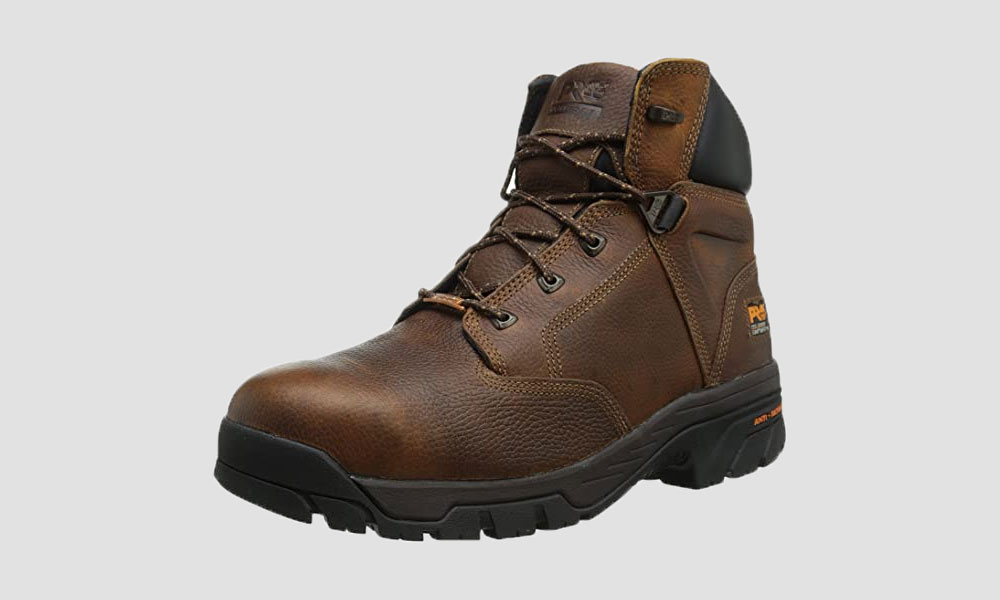
Construction, comfort, and fit
Here again we have a boot constructed around the TiTAN last, which aims to provide maximum protection without excess bulk. As such, the Helix 6” is imminently wearable, and built for walking long miles without discomfort.
Full-grain leather composes the uppers, which join to the sole via flexible cement construction. This method offers a powerful bond for superior durability, but without the stiffness that requires prolonged breaking in. Along the shaft and collar are rugged, dual-purpose lacing hardware. These enable you to get your shoes on and off fast, and to tie your boots for a snug fit along your tarsals and metatarsals.
Inside is the special Helix midsole, which consists of low-density EVA, pockmarked with a series of conical depressions. When you put your foot down, these cones compress to absorb the impact of footfall, then rebound to literally put a spring in your step. Combined with the PU insole, this system cradles your foot for optimal support–thus reducing fatigue. Beneath that is a nylon shank, which lends your safety boot extra rigidity.
While there’s plenty of material innovation to keep strain off your feet, the secret sauce is the PowerFit design paradigm. The parts of your safety boot which require heavy armour have it, whilst all else bears more flexible material for enhanced mobility and flexibility. The Helix 6” aren’t a marathon-runner’s shoes, but they might well carry you just as far.
Safety features
Of all our recommendations on this list of the best safety boots, the Helix 6” feature the lightest protections. This isn’t a knock against it, as some jobs specifically require mobility over sheer defence. Timberland has a tool for every task, so you should buy according to your needs.
Nevertheless, the Helix 6” achieves the ASTM F2413 standard. Centre stage is the lightweight but tough-as-nails alloy safety toe, which passes I/75 C/75 ratings with aplomb. This boot’s full-grain leather may be flexible, but it offers superior water resistance. And, in conjunction with a fully waterproof membrane lining the inside, you never have to worry about a swampy boot–even in standing water.
Water isn’t the only thing the Helix keeps out; the Timberland Pro outsole proves an effective barrier vs. corrosive oils, fats, acids, and chemicals. The rubber is naturally anti-slip on slick surfaces, and there’s even a special Ladder Lock radius built into the heel to provide extra grip on ladder rungs. And should you step on a live wire, rest easier knowing the Helix 6” features exceptional electrical insulation underfoot.
Looks and longevity
Nothing ruins leather faster than moisture, and the Helix 6” has plenty of ways to keep water out. But what about sweaty feet, damping up the interior of your boot? Timberland uses a special mesh lining that drastically cuts down on humidity, prolonging the life of your uppers. What’s more, the lining bears an antimicrobial treatment to keep your feet healthy and hard at work.
While we’ve focused a lot on the magic going on inside the Helix, we’d be doing you a disservice to ignore the exterior. This is a good-looking boot that wears well, especially if you keep the uppers waxed. The bold-grained brown leather uppers take abuse on the chin, and give back with a rugged appeal you’ll never have to worry about babying on the job.
Owing to its light weight (1.7kg) and cemented construction, you’ll be able to rely on these as long as the soles hold together. Depending on how much mileage you pull a day, this tends to run between a year or two. Because of their comfort and short break-in period, folks tend to become very attached to the Helix 6”, and don’t mind repurchasing every couple of years.
4. Timberland Pro Hypercharge 6” Composite Toe Work Boots
If rough terrain is part of the job, consider upgrading your personal suspension system. No, we’re not being cute; the Timberland Pro Hypercharge 6” has some advanced features that eat rough terrain for breakfast.
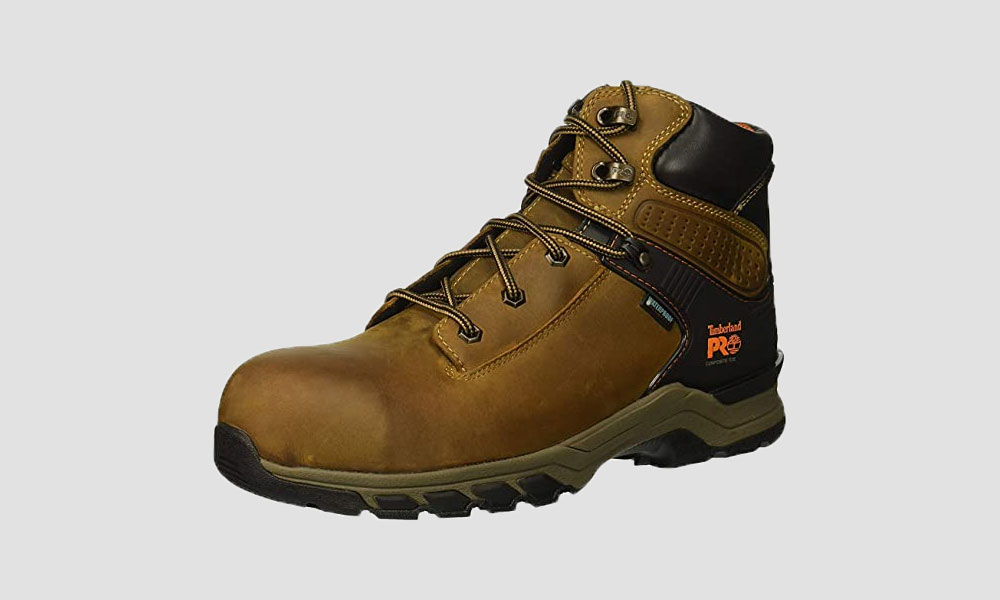
Of course, they’re high-impact safety boots as well, protecting nimble feet from hazards no matter which direction they come from.
Construction, comfort, and fit
The Hypercharge 6” features uppers made of Timberland’s best premium-quality full-grain leather. These connect to the rubber sole via cementing, forming a durable yet flexible bond.
A high-test rubber compound forms the counter that surrounds the heel. Not only does this help provide structure and support for your ankle, but it also serves as an anchor for the lace eyelets above the tarsals. This setup allows you to pull the laces tight without creating pressure points along the instep, and further boost the stability of your foot inside the Hypercharge.
Generous padding along the tongue, collar, and inside the shaft reduce unwanted wiggle room, helping you keep surer footing. Inside is Timberland’s patented anti-fatigue footbed, made of lightweight polyurethane dotted with conical impressions, plus the contoured shock diffusion plate which comes standard in most Pro-series safety boots. Together, these layers effectively soak up the energy of each step you take.
And at less than 1.6kg for the pair, the Hypercharge 6” won’t be weighing you down as you walk, climb, lift, or jump. While many will find these true to size, half sizes should plan to go up, as they’re very much on the narrow and tight side by design.
Safety features
The Hypercharge is all about stability, and this is apparent inside and out. We’ve already touched on the insole and midsole which pad your footfall, but there’s much more to appreciate than with the rest of Timberland’s Pro line.
The most notable inclusion is the ISN, which stands for independent suspension network. Essentially, this multi-density outsole is segmented into eight hinge-like sections. You can sort of think of it as a tank tread: smoothing over rocks, roots, inclines, and other uneven terrain with ease. Indeed, the treads are robust, and provide plenty of traction even in standing water or oil slicks.
Of course, a boot isn’t really a safety boot without an armoured toe compartment. The Hypercharge features a rugged composite toe box which sheds the weight and bulk of steel, but retains a similar level of protection. It is Timberland’s lightest toe material by a fair margin, and further contributes to the mobility of the Hybercharge.
With waterproof uppers and a sealed waterproof lining, you never have to worry about keeping your feet dry–even in standing water. What’s more, a breathable interior membrane staves off infection from blood-borne pathogens in accordance with ASTM F1671 standards.
Finally, Timberland’s Pro soles are HRO rated up to 300°, and provide exceptional electrical resistance when stepping on open circuits.
Looks and longevity
Unlike our other recommended Timberland safety boots, the Hypercharge offers less classic appeal and skews sporty in style. This is appropriate for its athletic use-case; clearly the terrain is the primary hazard these are meant to protect you from.
The Hypercharge 6” holds up well in the field, having been extensively tested by Timberland before release. Still, given that they’re meant for high-mobility applications, they’ll accrue mileage quickly and tend to give out after a year. You can extend the service life significantly by using Balm Proofer water repellent, as well as a wax leather protector.
Available in three colours: black, brown, and copper.
5. Timberland Pro Barstow Wedge Alloy Toe Work Boots
We wrap up our recommendations for Timberland safety boots with the Barstow. Its moc toe definitely stands out amidst the more technical entries in our list, but this design holds its own with heavy duty safety provisions.
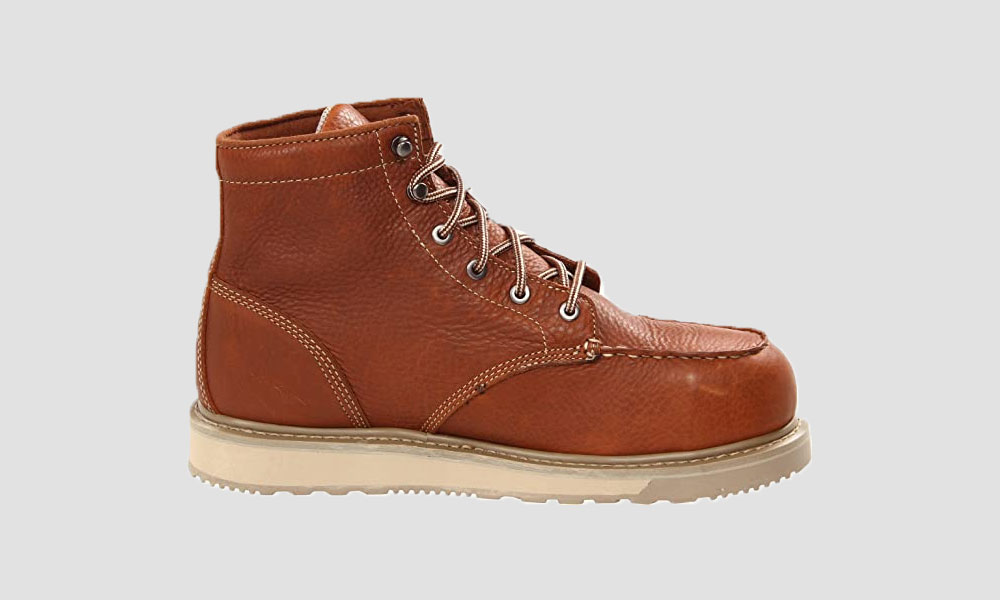
Construction, comfort, and fit
Unlike every other boot we’ve recommended thus far, the Barstow doesn’t have an interior lining. Instead, Timberland relies on the softness of their premium full-grain leather to provide a comfortable fit along the shaft. This is hardly a compromise, especially in hot weather where less material equals a cooler boot.
The Barstow’s uppers are joined together by a durable triple stitch, and to the sole with a Goodyear welt. Taken together, and you’ve got a boot held together by strong mechanical bonds for superior durability. Due to the lack of lining, however, the break-in period is surprisingly forgiving.
And, once the footbed and EVA midsole adapt to your foot shape, you’ll probably never want to wear another boot. Wedge soles are famously plush, and Timberland constructs the Barstow around maximising this outsole design’s comforting virtues. They’re easy to put on and off quickly too, with strong quick-lace lugs that won’t warp or break.
It also helps that there’s plenty of space inside; the Barstow 6” offers an EE width that everyone but the most narrow-footed will rejoice to wear. That said, you may wish to size down, as the soft, unlined leather will stretch as it breaks in.
Protection and resistance
Like many other models in Timberland’s Pro series, the Barstow’s insole features their anti-fatigue technology. This comes in the form of a dual-density foot bed which moulds to the foot, and efficiently absorbs impact and returns that kinetic energy to help you spring into your next step.
Essentially, Timberland views comfort as a safety feature, as fatigue on the job can easily lead to injury. Following this philosophy further, the Barstow’s tongue features an anti-microbial mesh lining. This keeps bacteria, fungus, and other humidity-based ailments away from your feet.
Of course, there’s plenty of physical protection too. Barstow’s alloy toe is moulded over the asymmetric TiTAN boot last, providing armoured protection that better fits the shape of your foot. It’s lightweight to further reduce fatigue, but fully durable with I/75 C/75 ratings.
Finally, there’s the Timberland Pro crepe wedge outsole, which offers superior grip on slippery surfaces; durable abrasion resistance; and resilience against fuels, oils, and other caustic chemical agents. Additionally, the thick rubber meets electrical safety standards against underfoot contact–indispensable if live wires and open circuits are part of the job.
Looks and longevity
There’s no way around it, moc toes make for sexy boots. This is a classic style, made even better by Timberland’s vast design expertise. The triple stitch and Goodyear welt scream workmanship, and you’ll find the leather ages with dignity and character.
The Barstow is the kind of boot that is safe enough for work; but comfortable and attractive enough to justify throwing a pair of jeans over, then going out to dinner still wearing them. They offer true all-day wearability, and if they meet the safety specifications of your job, you’d be hard-pressed to find another boot you’ll like better.
Considering the welt and quality uppers, there’s no reason your Barstows shouldn’t last a few years with proper care. Occasionally waxing the full-grain leather will not only protect it, but bake in the character of its wear–making your safety boots look that much better.
Understanding the build of your work boot
Product reviews typically assume that you have a fairly robust baseline of knowledge about the things you’re looking to buy. But when it comes to footwear, many of us just go with whatever works. Safety boots, however, are held to specific performance standards, and it is thus extremely useful to have a working understand of how they’re made. Here’s a crash course to get you orientated in your market research:
Uppers
It’s a bit of a strange term, but makes perfect sense once you understand. The uppers of your safety boots simply refer to everything above the sole; aka that beautiful construction of full-grain leather we tend to rave about in each boot review. Sometimes uppers are all a single piece of material, like with all-rubber work boots, but leather ones tend to consist of several components.
Those are:
- Vamps, which contain the armoured toe box and cover your most sensitive and fragile parts of your feet;
- Counters, which armour your heel and provide essential structure to your ankle;
- Shafts, which shields the rest of your foot and holds the fit snug;
- Cuffs, which sit atop the shaft and provide extra padding for comfort and security;
- Tongues, which protect your instep from getting rubbed raw by the laces;
- and Gussets, which connect the tongue to the shaft and form a barrier vs debris and moisture.
Soles
While the uppers hog all the glamour, the sole justifies the entire boot. Soles protect your feet from a litany of hazards, and make hours on your feet anything other than pure torture. While there are exceptions, safety boot soles typically consist of three layers:
- Outsole – The most robust and protective element of your work boots, which separate you from the ground. The best material for your outsole is a thermoplastic rubber compound, which wears extremely hard, grips vs. slips, and offers meaningful protection against water, electricity, oil and petrol, abrasions, and much more.
- Midsole – As you wouldn’t drive a car without shock absorbers, neither would you wear a boot sans midsole. These can be made of low-density EVA or multi-density PU, and may feature clever feats of engineering to further cushion the impact of footfall. Some boots also have armoured midsoles, which primarily protect your foot against puncturing by nails and other sharp objects.
- Insole – Also called the footbed, the insole is literally where your foot rests within the boot. It should be pliant enough to mould to your foot shape and cradle it in place. A good insole works in tandem with the midsole below to transfer the shock of each footstep to where it can be absorbed and rebounded. Many manufacturers coat their insoles in anti-microbial treatment, which cuts down on odour, fungus, and other swampy conditions that can arise of humidity within the boot.
Construction
If you read each review of Timberland’s best safety boots carefully, you might’ve noticed we mentioned three distinct methods of joining the uppers to the sole. Boot makers call this the “construction” of the boot. Let’s take a look at each:
Welted
The most common type of welt is the Goodyear welt, which double stitches the uppers to the soles. Because this is a mechanical bond, it’s extremely durable, and lends itself to service by a cobbler. That means that any welted boot can gain a second lease on life simply by replacing a worn sole!
The downside is that welts are stiffer, take longer to break in, and make for a more expensive boot.
Cemented
Industrial-strength chemical bonding agents make gluing work boots together a viable option. While these will never have the longevity of a Goodyear welt, they break in much more easily. What’s more, cemented boots are significantly lighter, and more cost-effective to produce.
And just because they’re not as strong as mechanical bonds, cemented boots can still withstand a couple of years’ worth of the most rigorous service. Don’t discount them, especially if budget is a primary concern.
Direct attached
Occupying something of a midpoint between cemented and welted boots is the direct attachment method. Essentially, boot makers create a mould for the outsole, place the uppers atop this mould, then fill it with molten rubber compound. As it dries and hardens in place, it grabs hard onto the uppers.
This method offers slightly better long-term durability than cemented construction, but even better flexibility and comfort. Direct attached work boots are more likely to feel like you’re wearing your trainers than any other protective footwear; but they still allow for incredible protection.
Armour
Finally, we come to what makes a safety boot safe: the armour. Safety boots almost always feature armoured toe boxes, but may also feature plated midsoles and met guards.
Toe boxes
Steel toed boots are practically synonymous with safety boots, and for good reason. These shield your toes and metatarsals from significant harm from falling impacts and compression. Steel is used for its durability, tensile strength, and relative affordability. That said, alloy toes offer similar levels of protection, but with significantly less weight in the boot.
But there are also non-metal toe boxes made of Kevlar, plastic, fibreglass, or carbon fibre. Yes, these also must pass the same tests as metal toe boxes, but confer additional advantages beyond weight reduction. Composite toes are idea for electricians, for whom any metal at all can increase the conductivity of their boots at their peril. Anyone working in strong magnetic fields will also appreciate the composite-toed work boot.
Plated midsoles
Even the most durable rubber compounds have a hard time keeping out nails and other sharp objects. This is where a plated midsole can literally be a lifesaver. Some manufacturers use steel, while others may use Kevlar or other composites. Whatever the case, you should expect a more rigid boot overall–and a more expensive one.
Safety boots with plated midsoles are the only boots capable of achieving an S3 safety rating.
Met guards
The least common form of armouring is the metatarsal guard. These tend to make for rather uncomfortable boots, at least until they have broken in significantly. But if you want total foot protection, there’s really no better bet.
Met guards reside underneath the tongue of your boot, and often attach to the armoured toe box. Whilst a crushing force landing on your met guard is still likely to hurt, the plate offers meaningful shielding and thus energy dispersal away from your fragile bones beneath.
How to make your safety boots last
There exist many in-depth guides on boot care, to be sure. But we tend to stress how simple it really is, so you’ll actually perform the maintenance that lets your work boots go the extra mile. Here’s a few rules of thumb:
- Keep them clean and dry. Leaving your boots caked in mud or oil is a great way to degrade the leather uppers. Also, you’ll want to keep an eye on the treads of your outsole; any rocks, nails, or tacks which have decided to hitch a ride will steadily wear away at the rubber with each step you take. But the worst environmental hazard for your boots is moisture. When you remove your boots at the end of a long day, store them someplace cool and dry, with cedar boot trees to help them air out. Never take a heater or blowdryer to your boots!
- Keep them polished. Leather takes a bit of elbow grease with dignity, and you’ll be impressed with how great they can look. Every scuff and scar can become a badge of honour and character, so long as you take the time to refinish the boot. Use polish which matches the colour of the leather, when you can.
- Keep them conditioned. This is really underrated advice, but it’s pretty obvious that leather wears out over time. The reason is primarily due to dehydration; leather was once living tissue, after all. Beeswax and specially compounded leather oils will soak into your uppers, making them supple yet strong again. Conditioning is also useful at the beginning of a boot’s life, since it also softens stiff leather.
How to decode safety standards
This isn’t meant to be an exhaustive guide, but the amount of safety statistics thrown around by boot manufacturers can be overwhelming and confusing. Here’s what you need to know about safety standards in the UK:
The UK adheres to Europe’s ISO 20345:2011 standard for footwear
As such, you can learn a lot about the quality of your boot by checking its label. In addition to the above marking, you’ll see:
- SB – Denotes an armoured toe box capable of withstanding 200J of impact energy.
- WR/WRU – Refers to a fully waterproof boot, or water resistant uppers only, respectively.
- P – Denotes resistance to puncturing through the sole, usually via a midsole plate.
- HRO – Heat resistance up to 300°C.
- A – Antistatic resistance up to 1000 MΩ.
- E – Essentially a measure of comfort, technically measured by the amount of energy absorbed by the heel.
- SRA/B/C – Traction ratings on progressively slipperier surfaces
You might also see S1/2/3 ratings, which take SB, A, E, and FO as a baseline (S1). S2 will add WRU to S1, while S3 adds P to S2. When in doubt, go for S3!
Your workplace may not always accept US standards
Many boots are marketed for the massive US market, and bear that country’s credentials instead of the EU’s. Whilst the testing methods differ, the protection the boot offers will often be comparable to EU/UK standards. Nevertheless, make sure to check with your employer whether US markings are acceptable.
Conclusion
Timberland makes one of the most iconic work boots on the planet, but that hasn’t stopped them from innovating. To wit, we’ve reviewed five of Timberland’s best safety boots, each suited to meet the demands of very different workplaces. While there’s a lot to know about what makes a good boot, we’ve provided you with everything you need to know to make an informed purchasing decision, and to make your investment last.